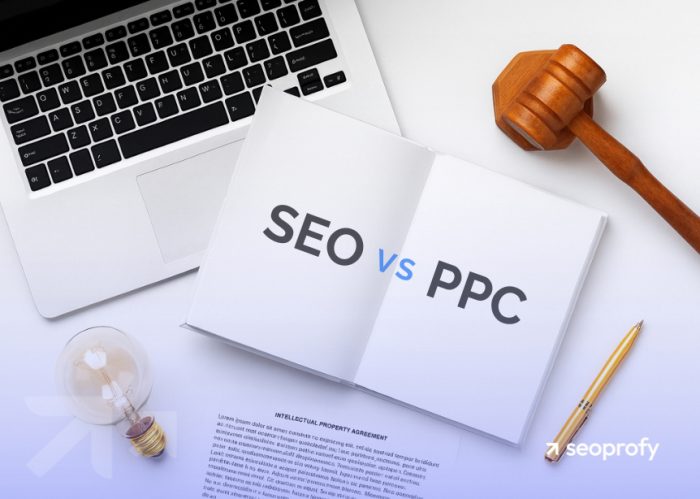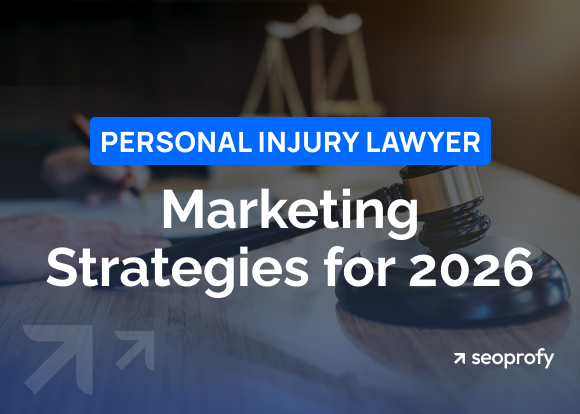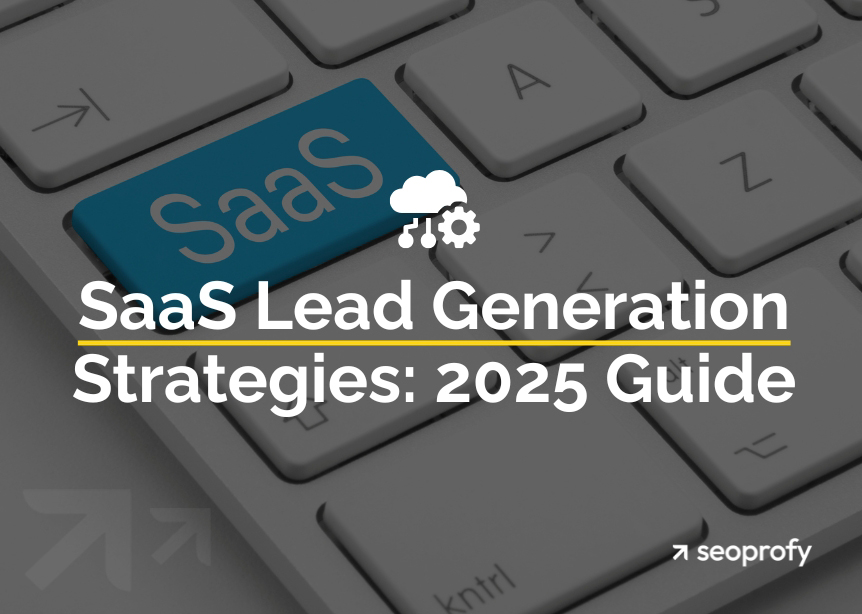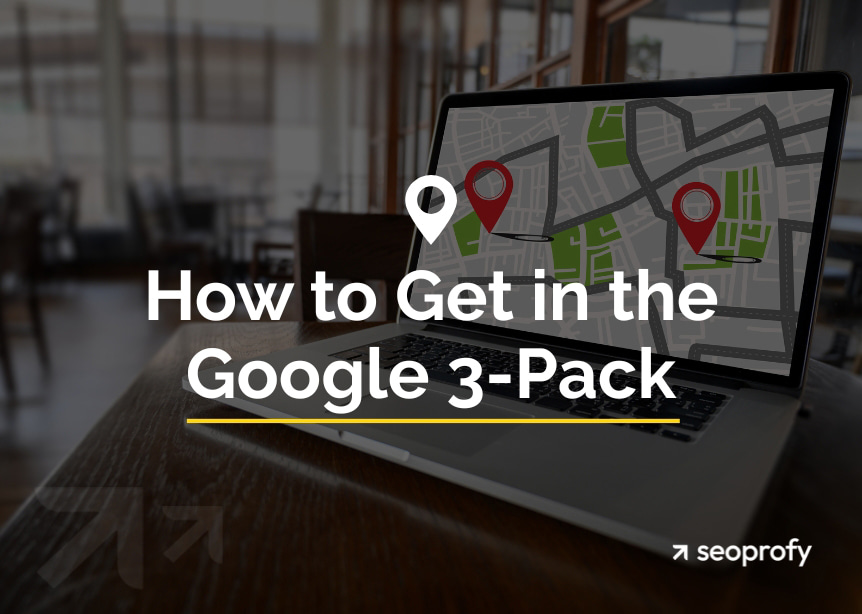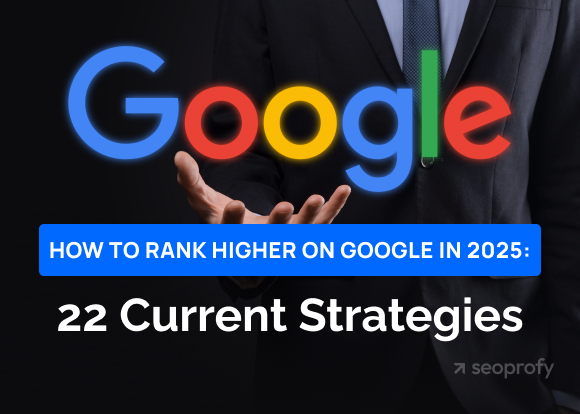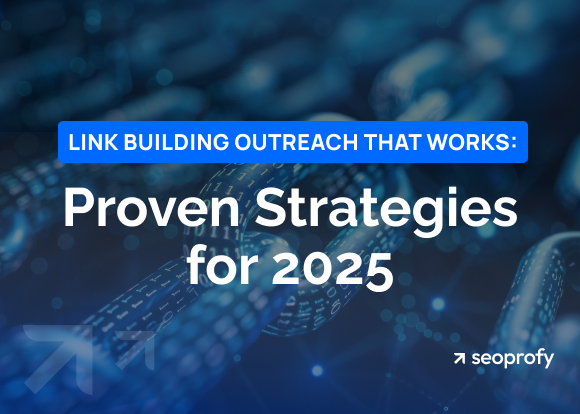Still stuck on “law firm SEO vs PPC which is better” in 2025? Here’s a hint. One pays you back long after the campaign ends. The other charges rent forever. If you don’t know which is which, this article might save your marketing.
Here you will find more than generic marketing advice. We compare law firm SEO and PPC with fresh 2025 data, real benchmarks, and clear takeaways. You will learn how to stop wasting budget, how to pick the right channel for your practice area, and how to create a pipeline that does not collapse when ad spend pauses.
- SEO focuses on authority and local visibility: content strategy, Google Business Profile optimization, and backlinks compound to win organic and map pack positions.
- PPC excels at precision and speed: campaign structure, keyword targeting, and landing page optimization allow firms to capture high-intent searches and scale budgets up or down quickly.
- A combined approach works best: using paid advertising while SEO builds momentum creates a steady lead flow and prevents the pipeline from collapsing when ads pause.
- Most firms benefit from expert help: about 83% of law firms outsource marketing, and partnering with specialists like SeoProfy helps execute these complex marketing strategies efficiently.
The Basics of SEO and PPC for Law Firms
Law firm SEO vs PPC: which is better? Well, there is no one-size-fits-all answer. To figure it out, you have to look at several factors and decide which ones matter most for your practice. The first step is to break down what each approach actually means.
What Is SEO for Law Firms
SEO for law firms means building online visibility that attracts clients without paying for every single click. In practice, it is the process of improving your website and digital presence so Google recognizes you as the most relevant answer for legal searches in your market.
Here is what it usually involves:
- Strategic content architecture: creating service pages built for conversion, writing long-form articles that establish expertise, building FAQ hubs that capture direct client questions, and producing resource content that builds topical authority across practice areas. Each content type is mapped to a funnel stage, from broad awareness queries to bottom-funnel “hire now” searches.
- Keyword strategy: targeting head terms like “personal injury lawyer” for visibility while layering mid-tail modifiers (“best car accident lawyer in Miami”) and long-tail queries that signal urgency and intent.
- Local dominance signals: optimizing and constantly updating Google Business Profile, earning reviews that influence organic search rankings and trust, and aligning NAP citations across Avvo, Justia, and other legal directories that Google treats as authority sources.
- Authority signals: building backlinks from bar associations, law journals, chambers of commerce, and reputable news outlets. These carry disproportionate weight in legal SEO because of their domain credibility.
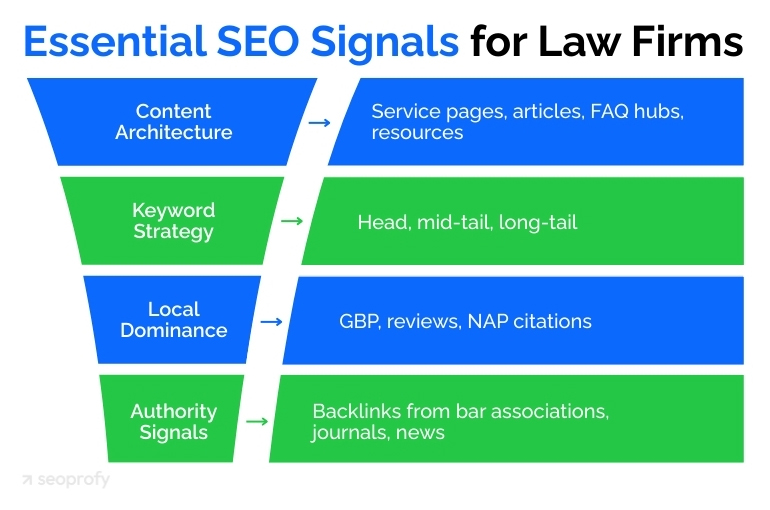
The strength of search engine optimization is compounding. Each page, each citation, and each link adds weight to your domain. Firms that stay the course usually reach breakeven after about 14 months, and from there, organic traffic tends to climb by roughly 21% each year.
So, over time, your cost per lead often drops below paid search while quality goes up, because potential clients arriving through organic search usually show higher trust. For law firms, this is the difference between renting visibility and building an asset that cannot be turned off with a budget freeze.
What Is Pay-Per-Click (PPC)
PPC for law firms is the practice of buying visibility in Google or Bing by paying each time a user clicks on an ad. It delivers exposure instantly, and about 58% of all traffic in the legal space comes from paid search. The flow of leads stops the moment the budget is paused, and in competitive markets, click costs often reach hundreds of dollars, which makes efficiency and targeting so critical.
Core elements of law firm PPC include:
- Structuring campaigns: creating separate ad groups for each practice area, geographic target, or case type. This avoids wasted spend and makes ad copy directly relevant to the search.
- Managing keywords: bidding on head terms like “personal injury lawyer,” protecting brand terms so competitors do not capture them, and refining match types and negative keywords to filter out irrelevant clicks.
- Optimizing landing pages: directing traffic to pages built for conversion with clear contact forms, call tracking, and language tailored to the specific case type.
- Controlling budgets: Monitoring cost per click and cost per lead in real time (for example, Google Ads data shows that the keyword “car accident lawyer” can cost around $258 per click). Budget allocation has to match the expected case value if the campaign is to remain sustainable.
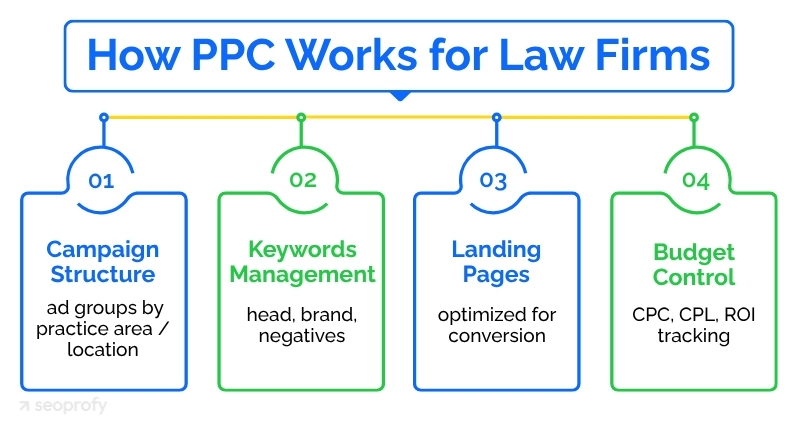
PPC brings speed, since campaigns can go live and start generating leads within days. The tradeoff is dependency. Once the spending stops, visibility disappears.
SEO vs PPC for Law Firms: Pros, Cons, and Key Differences
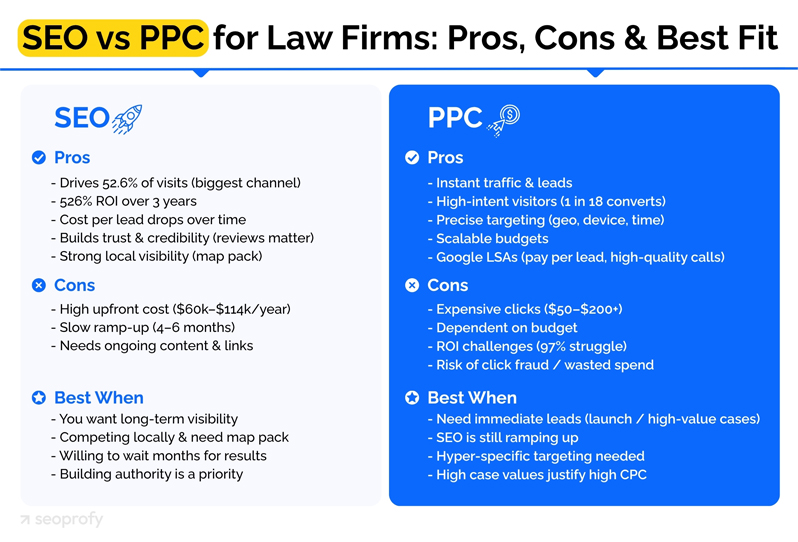
Before you decide whether SEO or PPC ads make more sense for your firm, it helps to see what each approach actually brings to the table. We will look closely at the advantages, the tradeoffs, and the quirks of both. Let’s walk through them first, then weigh the two approaches against each other.
SEO for Law Firms
We have already looked at what makes up law firm SEO. This section shows what optimization gives back in traffic, leads, and trust, and what it takes in time, budget, and upkeep, so you can judge its real value.
Pros of SEO
- Largest traffic driver: organic search accounts for 52.6% of visits to law firm websites, making it the most valuable channel by volume.
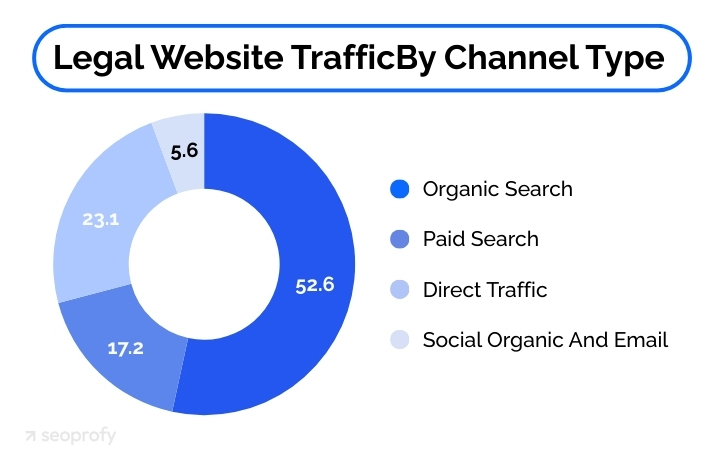
- Strong ROI: the average law firm sees a 526% return over three years, which compounds as authority grows.
- Dropping CPL: cost per lead declines over time as pages rank and backlinks accumulate, turning SEO into the most cost-efficient channel in the long run.
- Trust and credibility: organic results are perceived as more authoritative, and 40% of clients rely on online reviews when deciding which attorney to hire, which makes Google Business Profile optimization a key lever.
- Local SEO for lawyers: winning a spot in the map pack captures high-intent local searches and drives a stream of calls.
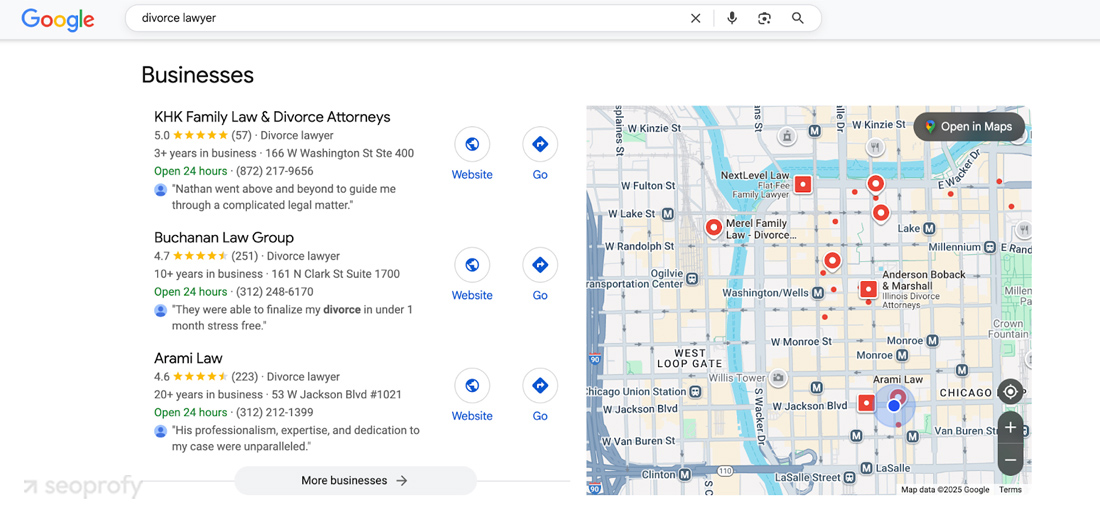
Cons of SEO
- Upfront spend: law firms typically invest $60,000 to $114,000 annually, which requires commitment before returns appear.
- Slow ramp-up: first results are usually seen after 4–6 months, meaning SEO does not solve short-term case pipeline gaps.
- Ongoing maintenance: rankings need constant reinforcement through new content, link building for lawyers, and technical upkeep.
When SEO Works Best
- When the goal is to own visibility long-term and not rely on ad spend.
- If the firm competes locally and needs to show up in the map pack organically and consistently.
- When the practice can wait months for results and prefers lower CPL over time.
- If building brand credibility and authority is as important as generating leads.
PPC for Law Firms
PPC is the fast lane of legal marketing: campaigns can start generating clicks and calls the same day they launch, but the visibility disappears as soon as the budget stops. This mix of speed and law firm marketing budget dependency makes PPC a channel worth examining carefully.
Pros of PPC
- Instant traffic: paid ads put a firm in front of prospects within hours, which is ideal for urgent case types or new practice areas.
- High-intent website visitors: people who click legal ads are often ready to act. Campaigns in this space see click-through rates just over 5% and convert roughly 1 in 18 visitors, which makes PPC a reliable driver of qualified leads.
- Precise targeting: campaigns can be segmented by practice area, zip code, device, or even time of day, helping to spend reach only the most relevant searches.
- Scalability: budgets can be increased during busy seasons and dialed back immediately if intake is full.
- Google Local Services Ads: these ads run above standard PPC results and charge per lead, not per click, often producing higher-quality calls in areas like personal injury and family law.
Cons of PPC
- High CPCs: competitive legal keywords can exceed $50-$200 per click, which makes cost control a constant challenge.
- Full budget dependency: lead generation for lawyers stops as soon as spending is paused, leaving no residual visibility.
- ROI concerns: research shows 97% of legal marketers running PPC report difficulty achieving a strong return, largely due to rising bid costs.
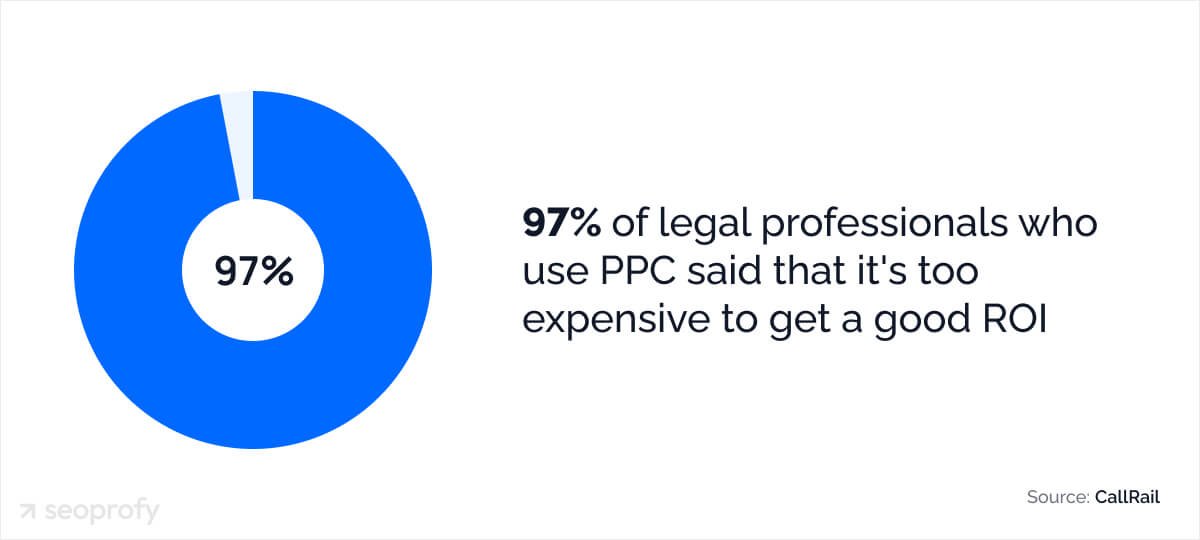
- Click fraud and wasted spend: poorly managed campaigns risk paying for accidental clicks or irrelevant traffic.
When PPC Works Best
- When immediate lead flow is needed, for example, during a firm launch or a push for a high-value case type.
- When the goal is to dominate organic search results while SEO campaigns are still ramping up.
- When targeting must be highly specific, such as restricting ads to certain neighborhoods, devices, or business hours.
- When case values are high enough to justify expensive clicks and still hit ROI targets.
Direct Comparison: Key Factors
To make the differences between SEO and PPC for lawyers easier to see, we put together a side-by-side comparison across the most important factors. Here is what we got:
|
Factor |
SEO for Law Firms |
PPC for Law Firms |
| Cost & ROI | Requires upfront investment and steady work, but the cost per lead trends downward as rankings hold. | Spend is immediate and ongoing. ROI depends on click costs and conversion rates, making careful management critical. |
| Speed of Results | Gradual build, takes months to gain traction but compounds over time. | PPC delivers instant visibility, campaigns can generate leads within days but the flow stops when spend stops. |
| Competitiveness | Once strong rankings are established they are harder for competitors to displace. | Placement depends on bids, competitors can outspend you to win in search engine results. |
| Client Trust | Organic listings and reviews create a sense of credibility and authority before a prospect even clicks. | Ads rely on strong landing pages and follow up to build trust post click. |
| Scalability | Growth is steady and, we would even say predictable (if done by the best SEO companies for law firms), as content and authority accumulate. | Highly flexible, budgets can be scaled up or down in real time. |
| Sustainability | Visibility remains even if you slow down investment provided the law firm’s website stays maintained. | No lasting effect, visibility disappears immediately when spend is paused. |
| Control & Targeting | Less direct control, rankings depend on search engines’ algorithms and ongoing optimization. | Full control over targeting, geography, device, schedule, and budget can be fine tuned. |
| Maintenance | Needs continuous optimization: content updates and technical work to maintain rankings. | Requires constant monitoring and bid adjustments to prevent wasted spend. |
Which Strategy Delivers Better Results for Law Firms?
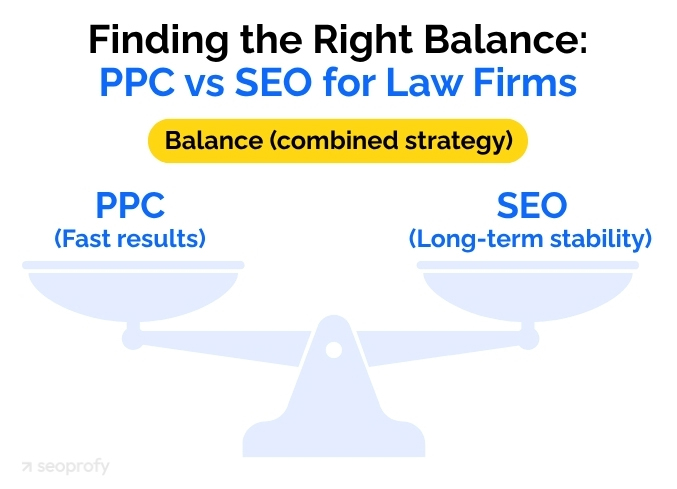
So, what should your business choose in the end: PPC, SEO, or maybe… both? You can find out for sure by taking a short quiz we have prepared.
Short Term: PPC Takes the Lead
When fast lead flow is the priority, the paid search approach wins. Paid search ads put your firm at the very top of Google within hours of launch. This is critical for new practices that need intake immediately or for firms running campaigns for specific case types where timing matters.
Long Term: SEO Builds a Stronger Asset
SEO marketing for lawyers is slower to start but compounds over time. Each page, link, and review strengthens your site’s authority and lowers cost per lead. For law firms that want predictable intake and trust signals that cannot be switched off with a paused budget, SEO is the better long-term investment.
Best Overall: A Balanced Approach
The smartest play for most firms is to use PPC for instant visibility while building SEO in parallel. PPC advertising fills the pipeline while SEO ramps up, then SEO gradually takes over as the cheaper, more stable lead source. This keeps the case flow steady and generally makes marketing spend more predictable.
Quick Strategy Test for Your Firm
Answer these six questions to see which approach is the best fit for your law firm:
- Do you have at least $7,000 per month available for SEO for a minimum of 6–12 months?
- Is building long-term brand authority a top priority for your firm?
- Do you want to compete for top positions in Google’s Local Pack and keep that visibility even if ad spend stops?
- Do you need leads this month to keep the pipeline healthy?
- Are you comfortable adjusting budgets month to month depending on caseload?
- Are most of your cases high-value, where a $200+ click still makes sense?
How to read your answers:
- Mostly yes to questions 1–3 → SEO is your best bet. It builds lasting visibility and credibility, and lowers cost per lead over time.
- Mostly yes to questions 4–6 → PPC is the stronger play. It gives you immediate visibility, budget flexibility, and the ability to compete for high-value cases right away.
- A mix of yes answers across both groups → you are a perfect candidate for a combined strategy.
How can SEO and PPC work together for law firms? In the next section, we will show how combining these two approaches creates a stronger, more resilient marketing system for law firms.
SeoProfy helps law firms show up when people are actually looking for legal services. You get:
- More visitors are reaching your site
- Calls and form fills that keep coming
- Full clarity on what you’re paying for

How SEO and PPC Work Together in Legal Marketing
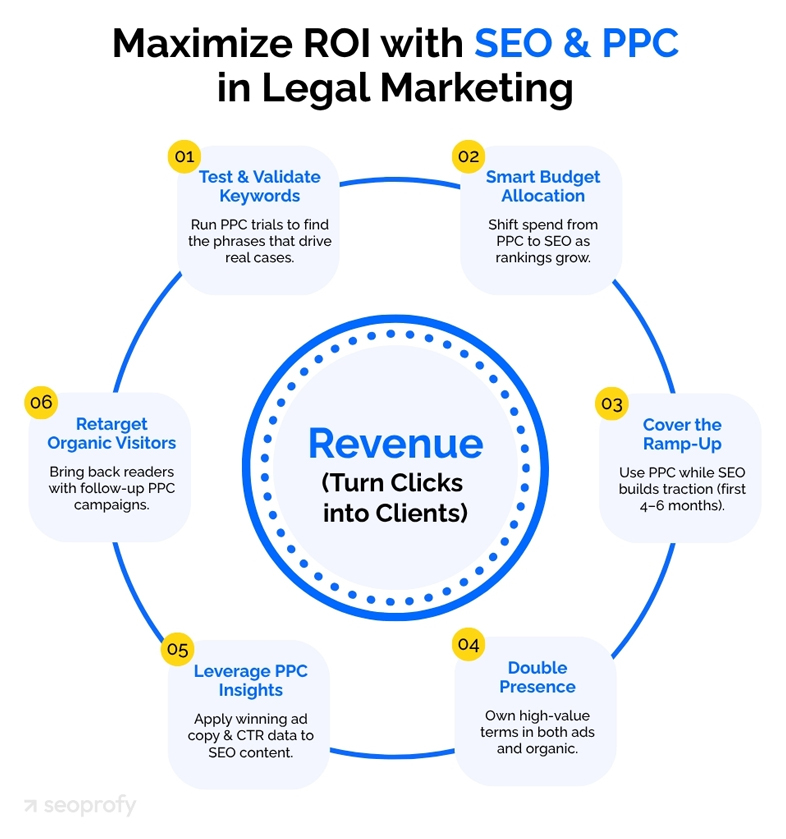
Using SEO and PPC marketing for attorneys together turns them from competing channels into a single client-acquisition system. Instead of splitting the budget and hoping one performs better, you let each channel do what it does best. There are some strategies for using these approaches in a mix that separate pro marketers from beginners. Those are exactly what we cover below!
Use PPC to Test and Validate Keywords
Before committing to a full SEO audit and months of optimization, PPC data can reveal which search terms actually drive qualified cases. Running short campaigns on practice-specific terms like “truck accident lawyer” or “divorce mediation attorney” shows which ones bring calls and which ones waste spending. Once you know the winners, you can invest SEO resources into building service pages and content hubs for those exact phrases.
Control Costs with Smart Budget Allocation
Combining SEO and PPC lets you shift spending dynamically. As organic rankings take over for certain keywords, reduce PPC bids on those terms and reinvest into new campaigns or legal content writing. This keeps the total cost per lead dropping over time while still keeping volume stable.
Use PPC While SEO Gains Traction
SEO strategies take time to build authority and climb the rankings. When you’re just starting to grow a law firm, PPC fills the gap. Launch campaigns around your highest priority practice areas so your firm is visible while new pages get indexed and backlinks are earned. This keeps the pipeline active during the first 4 to 6 months of an SEO campaign (which is often when partners get impatient waiting for organic traffic).
Double Up on High-Value Keywords
Some keywords are worth owning twice, in ads and in organic. For example, if “personal injury lawyer near me” converts into high-value cases, appearing both in the map pack and in the top paid slot maximizes the chances that a prospect clicks you and not a competitor. This is especially powerful in competitive metros, where one lost click can mean losing a six-figure case.
Use PPC Campaigns Data to Improve SEO Content
Search terms and ad copy with the highest click-through rates can inspire headlines and meta descriptions for SEO pages. If a certain call to action in ads gets more calls, work that language into your organic content. Over time, this raises organic click-through rates and improves performance without increasing ad spend.
Retarget Visitors Who Found You Organically
SEO brings a lot of first-touch traffic from people who are still in the research stage. Retargeting campaigns bring them back later when they are closer to hiring. Showing ads to users who read your “how long do I have to file a claim?” guide can convert them into consultations once they are ready to act.
Partnering with the Right Digital Marketing Agency for Law Firms
Implementing strategies that combine SEO and PPC at a professional level calls for strategists, technical SEO specialists, content writers, link builders, and analysts working in sync. Building that kind of team in-house is costly and time-consuming, which is why delegating to a proven agency is often the smarter move. In fact, about 83% of law firms rely on external search marketing partners to manage their digital growth.
At SeoProfy, our team has extensive experience helping law firms compete online. We run campaigns for multiple practice areas, including:
- SEO for Bankruptcy Lawyers,
- SEO for Immigration Lawyers,
- SEO for Criminal Defense Lawyers,
- SEO for Family Lawyers,
- and more.
Working with us means your technical setup is polished, your content targets the exact searches your prospects make, and your site earns the authority that drives consistent rankings. Each campaign is measured against ROI, so you know exactly what your investment is producing.
Ready to grow your case pipeline? Talk to our team today and get a strategy session designed for your firm’s practice areas and goals.


